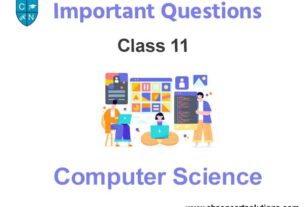Students can read the important questions given below for Relational Databases Class 11 Informatics Practices. All Relational Databases Class 11 Notes and questions with solutions have been prepared based on the latest syllabus and examination guidelines issued by CBSE, NCERT and KVS. You should read all notes provided by us and Class 11 Informatics Practices Important Questions provided for all chapters to get better marks in examinations. Informatics Practices Question Bank Class 11 is available on our website for free download in PDF.
Important Questions of Relational Databases Class 11
Short Answer Type Questions
Q.1 What is a database system? What is its need?
Ans: A database is a collection of information that is organized so that it can be easily accessed, managed and updated. Data is organized into rows, columns and tables, and it is indexed to make it easier to find relevant information. Data gets updated, expanded and deleted as new information is added. Databases process workloads to create and update themselves, querying the data they contain and running applications against it. The software which facilitates the collection of database and its retrieval is known as DBMS. A database along with a DBMS is referred to as a database system.
DBMS is needed to overcome the following problems in traditional file system – (i) Data redundancy (ii) Data inconsistency (iii) Unstandardized data (iv) Insecure data (v) Incorrect data etc. In DBMS these limitations has been almost reduced.
Q.2 What are the disadvantages of database systems?
Ans: When we work with complex task then there may be some disadvantages of using databases these are –
(i) Security may be compromised without good controls.
(ii) Integrity may be compromised without good controls.
(iii) Extra hardware may be required.
(iv) Performance overhead may be significant.
(v) System is likely to be complex.
Q.3 What are views? How they are useful?
Ans: A view is a virtual table that does not really exist in its own right but is instead derived from one or more underlying base tables(s). the view is a kind of table whose contents are taken opon other tables depending upon a given query condition. No stored file is created to store the contents of a view rather its definition is stored only.
The usefulness of views lies in the fact that they provide an excellent way to give people access to some but not all of the information in a table.
Q.4 What is the purpose of using MySQL?
Ans: MySQL is a free, open source Relational Database Management System (RDBMS) that uses Structured Query Language (SQL). In MySQL database, information is stored in Tables. A single MySQL database can contain many tables at once and store thousands of individual records.
Q.5 What do you understand by MySQL server instance?
Ans: MySQL server instance is created from background processes and applications.it stays in memory and listens for client requests coming in over the network amd accesses database contents according to those requests and provides that to the clients.
Q.6 What do you understand by MySQL client?
Ans: MySQL clients are programs that connect to the MySQL server and issue queries in a pre-specified format. MySQL is compatible with the standards based SQL. The client program may contact the server programmatically or manually.
Q.7 What is SQL? What are different categories of commands available in SQL?
Ans: In order to access the data within Oracle databases, all programs and users must use, Structured Query Language (SQL). SQL is the set of commands that is recognized by nearly all RDBMSs. SQL commands can be divided into following categories –
(i) Data Definition Language (DDL) Commands.
(ii) Data Manipulation Language (DML) Commands.
(iii) Transaction Control Language (TCL) Commands.
(iv) Session Control Commands.
(v) System Control Commands.
Q.8 Differentiate between DDL and DML commands.
Ans: The DDL commands, as the name suggests, allow you to perform tasks related to data definition i.e. through these commands you can perform tasks like create, alter and drop schema objects, grant and revoke privileges etc.
The DML commands, as the name suggests, are used to manipulate data i.e. DML commands query and manipulate data in existing schema objects like, Select query, insert into command etc.
Q.9 What is MySQL? What are its functions and features?
Ans: MySQL is a free, open source Relational Database Management System (RDBMS) that uses Structured Query Language (SQL). In MySQL database, information is stored in Tables. A single MySQL database can contain many tables at once and store thousands of individual records.
Its functions and features are –
(i) Speed
(ii) Ease of use
(iii) Cost
(iv) Query Language support
(v) Portability
(vi) Data Types
(vii) Security
(viii) Scalability and Limits
(ix) Connectivity
(x) Localization
(xi) Clients and Tools
Q.10 Name some commands used to assign/revoke privileges from database users.
Ans: Grant Privilege Command and Revoke Privilege commands.
Q.11 Name some Table maintenance commands?
Ans: ANALYZE TABLE , CHECK TABLE , CHECKSUM TABLE , OPTIMIZE TABLE , REPAIR TABLE



